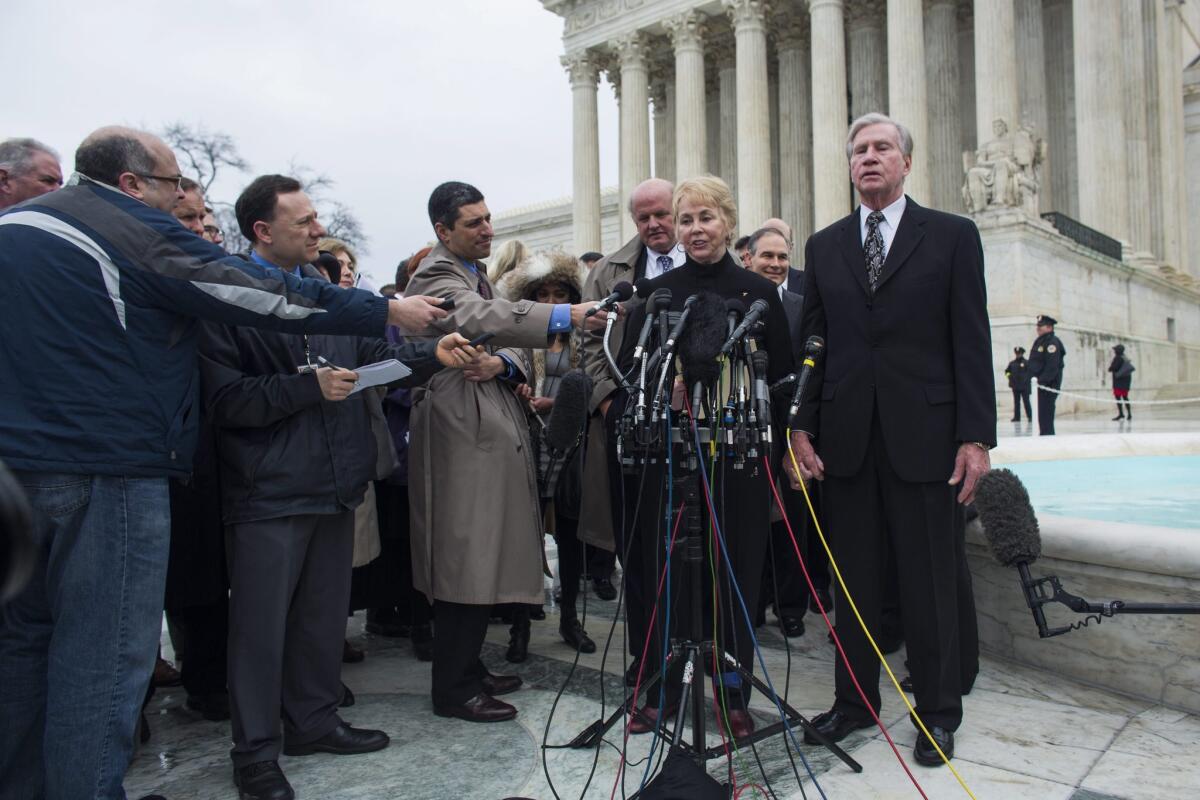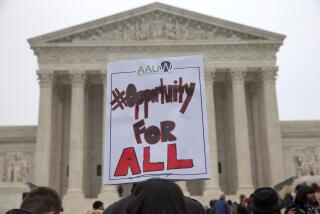Op-Ed: A middle way to resolve the Obamacare case

At the Supreme Court argument in King vs. Burwell, the case challenging how the Affordable Care Act works, someone should have asked, “If a state with a federally run health insurance exchange now adopts or ratifies that marketplace as its own, wouldn’t it qualify as a state-established exchange?” An affirmative response opens a middle way out of the dilemma posed by that lawsuit.
First the facts. Thirteen states run their own exchanges. A few more do so in partnership with the federal government. The remaining states, including some controlled by Democrats who support the law, leave this task entirely to the feds. On its face, the law says that federal subsidies designed to make insurance affordable for middle-class people not covered by their employers are available for policies purchased on exchanges “established” by states. The Obama administration has interpreted this provision to include “state” exchanges run by or in partnership with the feds. Opponents disagree. The court will decide.
Both sides agree that without subsidies, exchanges would collapse under the weight of too many high-risk applicants. In states without federal subsidies, the Affordable Care Act’s signature promise of access to affordable medical insurance would fail. Both sides also agree that a state could gain subsidies for its citizens by establishing an exchange.
This creates a middle way for states currently without their own exchanges. First, the court would need to give those states time to establish exchanges. At the oral argument, even Justice Samuel A. Alito Jr. conceded that, to avoid immediately depriving subsidized people of insurance in the middle of their current policies, the court could stay its decision to year’s end. That would give states about six months to establish their exchanges after the Supreme Court’s anticipated ruling in June.
Perhaps some states would meet this deadline by creating new exchanges, but many could not. If the Supreme Court opinion held that states could meet the requirement by formally ratifying or adopting existing federal ones, then every state could easily meet the deadline if it chose to. If it declined, then federalism would prevail and subsidies would end for that state. Here is a middle way that preserves federalism without the sort of coercion that worried Justice Anthony M. Kennedy during oral arguments.
Such an approach is akin to how the court handled Medicaid expansion. States must opt in. The overall promise of the Affordable Care Act was hollowed out for low-income residents in states that chose not to expand Medicaid coverage, but expansion still worked elsewhere.
Acknowledging this point, some commentators suggest that an adverse ruling in King vs. Burwell would still fatally undermine the Affordable Care Act by unraveling the employer mandate, which penalizes only those employers with employees receiving federal subsidies under the exchanges. They exaggerate.
Again, the facts. The so-called employer mandate is really a nudge. Small employers are exempt. Even for large employers, the per-employee penalty for not providing insurance is less than the cost of that insurance. This makes it more like a tax to fund federally subsidized insurance than a mandate for employers to provide coverage. For multi-state employers with employees in some states with complying exchanges, the mandate would be triggered for all employees in any event, so the effect of the court’s ruling would be limited to those with employees solely in states with noncomplying exchanges.
Though this middle way would further gut the law’s promise of access to healthcare in states opting not to establish exchanges, it need not undermine it everywhere. The employer penalty is designed to help fund the subsidies. If the subsidies become unavailable in some states, as a purely accounting matter, the savings in subsidy payments should exceed any lost revenue from the employer mandate. The law should be able to continue functioning.
If by not adopting the federal exchange as its own, a state chooses to forgo free federal money in the form of subsidized health insurance for its middle-class citizens, and if those citizens reelect the governor and legislators making that decision, then perhaps that is the cost of federalism, at least as this court conceives it. Meanwhile, others can continue receiving the benefits of the Affordable Care Act.
This middle way would require the high court to stay the effect of any ruling against the law until at least the end of 2015 and to affirm that states can establish exchanges by accepting or ratifying those already created by the federal government. Such an approach may appeal to swing justices — middle ways often do.
Edward J. Larson, a health law professor at Pepperdine University, won the Pulitzer Prize for “Summer for the Gods,” his book about the Scopes trial. He worked with Congress on earlier versions of health-insurance reform.
Follow the Opinion section on Twitter @latimesopinion and Facebook
More to Read
Start your day right
Sign up for Essential California for news, features and recommendations from the L.A. Times and beyond in your inbox six days a week.
You may occasionally receive promotional content from the Los Angeles Times.





